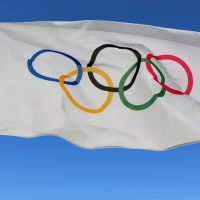

The Olympic rings are synonymous with the peak of international sports achievement. Those five interlaced circles of equal size, each a different colour, absolutely dominate the sporting landscape around the globe for two straight weeks before vanishing as quickly as they appeared, hiding away until the next games, usually around two years later.
But where did these rings come from? What do they mean? Who made them? And have they ever changed over the years?


The five Olympic rings debuted in the August 1913 edition of Olympique. They were designed by Pierre de Coubertin, who also founded the modern Olympic games.
The six colours of the Olympic rings (the five rings plus the white field) were chosen to incorporate the colours from every competing nation’s flag of the time; the ring colours are (from left to right) blue, yellow, black, green and red. The five rings themselves represent the five continents: Africa, the Americas (North and South), Asia, Europe, and Oceania.


“The six colours combined in this way reproduce the colours of every country without exception,” de Coubertin wrote in that August 1913 Olympique magazine. “The blue and yellow of Sweden, the blue and white of Greece, the tricolour flags of France, United Kingdom, the United States, Germany, Belgium, Italy and Hungary, and the yellow and red of Spain are included, as are the innovative flags of Brazil and Australia, and those of ancient Japan and modern China. This, truly, is an international emblem.”
LINK: The 2024 Paris Olympics logo explained
The creation of the rings coincided with the 20th anniversary of the revival of the Olympic games, conceived in 1894 and held in 1896. The Olympic flag, featuring the five rings on a white field, was to be unveiled at the IOC Congress in Paris in 1914; however, the event was cancelled due to the onset of The Great War. The rings were first flown on a flag at the 1914 Pan-Egyptian Games in Alexandria; their first Olympic Games appearance was during the opening ceremony of the 1920 Olympic Games in Antwerp, Belgium.


LINK: A history of Summer Olympics logos and posters: 1896-2028
Over the years, the Olympic rings have been modified slightly. In 1957, they were changed to intersect and be spaced differently. In 1986, white trim was added around each ring which created a visual gap between each one. The rings were re-united in 2010, restoring the original intention of a truly interlinked design.














